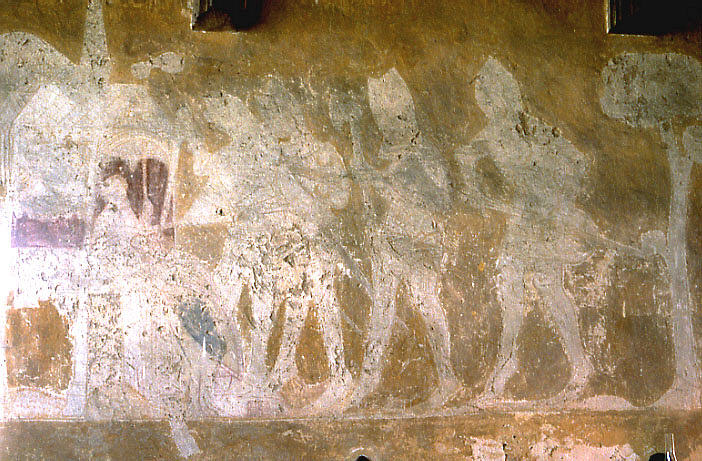South Burlingham, Norfolk (†Norwich) C.14/15
The Murder of Thomas Becket

The painting is now literally dilapidated, by which I mean that the plaster on which it is painted is visibly flaking off. This is not due to indifference on the part of the clergy and congregation, whose efforts to preserve their church are heroic, but their major preoccupation, understandably, is keeping the (thatched) roof on. The painting of the Murder of Becket, ghostly as it is now, must have been very striking at one time. It is remarkable that it still exists at all, given Henry VIII’s attitude to anything commemorating the saint – all depictions of and even references to him were to be expunged thoroughly from churches.¹
At the far left, a medieval building with both pointed and rounded arches is still just visible. Under a rounded arch, intended for a doorway, Edward Grim, Thomas’s chaplain, can still be seen standing against a red ochre background. Below him, St Thomas himself has almost completely gone, but the curve of his body as he kneels before the altar, itself still visible at the extreme left, can just be made out. To the right, the four knights are a little clearer. The leading figure thrusts horizontally towards Becket with a sword (not easy to see). A second behind and slightly to the left strikes dramatically downward towards the saint’s head with a short sword or dagger. The third figure to the right holds (upright) a battle-axe, and he has been identified as Reginald FitzUrse, from his emblem of a bear painted on his shield, although this detail is no longer visible. A fourth knight beyond draws his sword from its scabbard, and beyond him is a tree, to suggest the movement of the knights from outside and up to the altar.
South Burlingham has other paintings – the remains of a St Christopher confused with an earlier painting of St George and the Dragon below it, and some indecipherable painting in a niche. The 15th century pulpit has a painted inscription celebrating John the Baptist – ‘Inter natos mulierum non surrexit maior Johanne Baptista’²
¹ Remarkable testimony to the reluctance with which Henry’s order was carried out is nearby at Ranworth (Norfolk) in the late 15th century Antiphoner. A page containing a reference to one of Becket’s feasts has been crossed out with the lightest possible of single diagonal strokes, leaving everything on it perfectly readable.
² ‘Among those born of women has not risen a greater than John the Baptist’ [Luke 7:28]